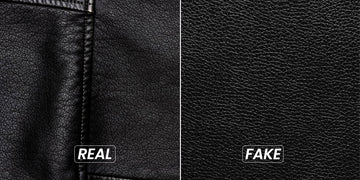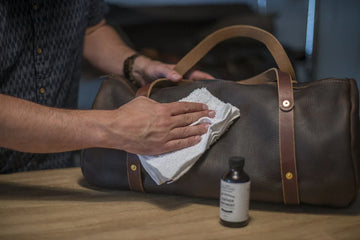Leather has long been prized for its durability, elegance, and timeless appeal — but with today’s market flooded with synthetic alternatives, telling genuine leather from fake can be tricky. While real and faux leather may look alike at first glance, they differ greatly in texture, smell, price, and longevity. This guide of KitArt Leather will show you the key differences and simple tests to help you confidently identify authentic leather every time.
What Are the Main Differences Between Real and Fake Leather?
Leather has been used for centuries in clothing, accessories, and furniture because of its durability, unique texture, and timeless look. However, the market today is filled with synthetic alternatives, often called faux leather or PU leather, which are made from plastic-based materials. At first glance, real and fake leather can look almost identical, but once you know what to look for, it becomes much easier to tell them apart.
This guide will walk you through the key differences between genuine and faux leather, as well as some practical tests you can use to identify the real thing.
|
Feature |
Real Leather |
Fake Leather |
|
Origin |
Animal hides |
Plastic-based (PU/PVC) |
|
Texture |
Soft, flexible, unique grain |
Smooth, uniform, sometimes plasticky |
|
Smell |
Rich, earthy, natural |
Chemical, synthetic, or glue-like |
|
Durability |
Can last decades |
Usually peels/cracks within years |
|
Water |
Absorbs moisture |
Repels water |
|
Cost |
Expensive |
Cheaper |
|
Aging |
Develops patina (gets better with time) |
Looks the same until it cracks |

How to Identify Real Leather vs Fake Leather?
Check the Label
A quick way to identify whether leather is authentic is by reading the product tag.
If the label includes terms like synthetic, PU leather, leatherette, vegan leather, or polyester, the item is made from man-made materials rather than genuine animal hide.
Premium brands often provide certificates of origin. For instance, Von Baer bags feature marks such as Pelle Conciata al Vegetale in Toscana or Cuoio Superiore, confirming that the product is crafted from traditional Tuscan vegetable-tanned leather in Italy.
Feel the Surface
Touch is one of the most reliable indicators.
Authentic leather is soft yet strong, slightly elastic, and shows a natural grain with small variations. It also warms quickly when held.
Artificial leather, by contrast, feels colder, more rigid, and has a plastic-like finish with little to no stretch.

Do the Smell Test
The scent of real leather is unmistakable—rich, earthy, and natural.
Faux leather often smells of chemicals or plastic, while higher-end synthetics may have almost no scent.
When uncertain, let your nose decide: the smell of genuine leather cannot be reproduced.
Examine the Grain
Animal hide naturally has uneven pores, textures, and grain patterns. These tiny imperfections are proof of authenticity.
Synthetic leather usually lacks these details. Even if an artificial grain is printed, it often looks overly uniform and “too perfect.”
Try the Flame Test (with caution)
This method should only be used on hidden areas and not on valuable goods.
Hold a flame near the material for a few seconds:
-
If it burns quickly and releases a chemical odor, it’s fake.
-
If it chars slowly and smells like burnt hair, it’s real leather.
Look at the Edges
Machine-made faux leather typically has neat, smooth, and even edges.
Real leather edges are rough, fibrous, and naturally inconsistent—especially noticeable on smaller items like belts, wallets, or handbags.
Check Flexibility
When bent, authentic leather creases naturally, forms wrinkles, and may slightly change shade. It also has elasticity.
Fake leather is stiffer, harder to bend, and does not behave the same way.
Test with Water
Place a drop of water on the surface:
-
Real leather absorbs it within a few seconds.
-
Fake leather repels water, leaving it sitting on top.
Compare Prices
Genuine leather products—whether jackets, sofas, or handbags—are typically much more expensive than synthetic versions. If a deal seems suspiciously cheap, the item is likely not authentic.
Be aware of leather grades too: full-grain or top-grain leather costs more than corrected or bonded leather. Special finishes such as nubuck, Nappa, or patent leather also influence price.
That said, luxury fashion brands sometimes price vegan leather higher than real leather due to exclusivity and branding, as seen with designers like Stella McCartney.
Don’t Rely on Color
Both natural and artificial leather can be dyed into nearly any shade.
Bright or unique colors don’t prove authenticity—texture, scent, and overall craftsmanship are far more trustworthy indicators.
A Guide to Different Types of Real Leather
Understanding leather types helps you know what quality you’re paying for:
Full-Grain Leather
The highest quality leather, made from the entire hide with all natural imperfections intact. It develops a rich patina over time, making it more beautiful with age. Extremely durable and commonly used in luxury wallets, belts, boots, and shoes.
Top-Grain Leather
The second-best grade. The surface is sanded and treated to remove flaws, giving it a smooth and uniform look. Slightly less durable than full-grain, but still strong and popular in handbags, jackets, and accessories.
Genuine Leather
Real leather, but from the lower layers of the hide. More heavily processed, less durable, and doesn’t age as well. Found in mid-range products like casual wallets, belts, and affordable footwear.
Split Leather
Made from the inner layers of the hide, often coated with polyurethane to look better. Weaker and less long-lasting, typically used in cheaper goods or linings.
Bonded Leather
Lowest grade, made from scraps and fibers glued together with plastic. Prone to peeling and cracking, usually found in budget furniture and low-cost accessories.
Real leather is a long-term investment—it’s natural, durable, and gets more beautiful with age. Fake leather may be cheaper and animal-free, but it often doesn’t last.

Why You Should Choose KitArt Leather?
At KitArt Leather, we believe every leather product should tell a story of craftsmanship, quality, and timeless style.
We are a trusted leather workshop specializing in handcrafted genuine leather goods, from wallets, belts, and bags to custom-made accessories. Each item is carefully made by skilled artisans, ensuring durability, elegance, and a unique touch that mass-produced products can never replicate.
-
Authentic Materials: We use only high-quality genuine leather, selected for its strength, natural beauty, and ability to age gracefully.
-
Handcrafted Excellence: Every piece is made by hand with attention to detail, combining traditional techniques with modern design.
-
Durability & Style: Our products are built to last, improving with use and developing a unique patina over time.
-
Trusted Brand: With a reputation for quality, honesty, and customer satisfaction, KitArt Leather has become a reliable name for leather lovers.
Whether you’re looking for a stylish everyday wallet, a statement handbag, or a personalized gift, KitArt Leather delivers products that are both functional and sophisticated.
By practicing the 10 identification methods (label, feel, smell, grain, flame test, edge check, flexibility, water absorption, price, and color check), you’ll be able to confidently spot the difference.
When shopping, remember:
-
If it’s too cheap to be true, it’s probably fake.
-
If it smells and feels natural, it’s probably real.

















